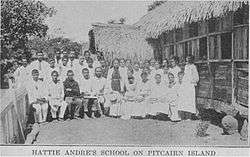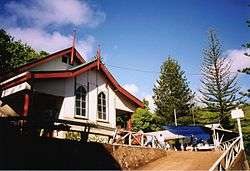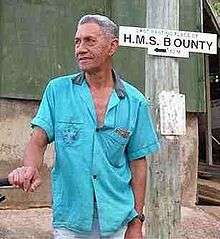Pitcairn Islanders
| |||||
| Total population | |||||
|---|---|---|---|---|---|
|
(54 (2012 Census)[1] 45 (Resident islanders) & 9 (overseas professionals)) | |||||
| Regions with significant populations | |||||
|
| |||||
| 38.4% (2011)[2] | |||||
| 201 (2006)[3] | |||||
| 15 (Households)[3] | |||||
| Languages | |||||
| English · Pitkern | |||||
| Religion | |||||
| Seventh-day Adventist Church | |||||
| Related ethnic groups | |||||
| English · Tahitians · Scottish · Irish · Descendants of the Bounty mutineers · | |||||
Pitcairn Islanders also referred to as Pitkerners, are the inhabitants or citizens of the Pitcairn Islands. The Pitcairn Islands is a nation, home to people of different ethnic and national backgrounds. Despite its composition, the culture held in common by most Pitcairn Islanders is referred to as mainstream Pitcairn culture, a mix of British and Polynesian culture largely derived from the traditions of settlers, primarily of English, Scottish, Tahitian descent (descendants of the Bounty mutineers) and other Polynesians.[4]
There is also a Pitcairn diaspora particularly in New Zealand, Norfolk Island and mainland Australia as a result that in 1856 all 193 Pitkerners immigrated to Norfolk Island but 16 of them returned to Pitcairn the following year followed by a further four families in 1864.[3]
History
Pitcairn Island was sighted on 3 July 1767 by the crew of the British sloop HMS Swallow, commanded by Captain Philip Carteret. The island was named after Scottish Midshipman Robert Pitcairn, a fifteen-year-old crew member who was the first to sight the island. Robert Pitcairn was a son of British Marine Major John Pitcairn, who later was killed at the Battle of Bunker Hill in the American Revolution.
In 1790, nine of the mutineers from the Bounty, along with the native Tahitian men and women who were with them (six men, eleven women and a baby girl), settled on Pitcairn Islands and set fire to the Bounty. The wreck is still visible underwater in Bounty Bay, discovered in 1957 by National Geographic explorer Luis Marden. Although the settlers survived by farming and fishing, the initial period of settlement was marked by serious tensions among them. Alcoholism, murder, disease and other ills took the lives of most mutineers and Tahitian men. John Adams and Ned Young turned to the scriptures, using the ship's Bible as their guide for a new and peaceful society. Young eventually died of an asthmatic infection. The Polynesians also converted to Christianity. They later converted from their original form of Christianity to Seventh-day Adventism, following a successful Adventist mission in the 1890s. After the rediscovery of Pitcairn, John Adams was granted amnesty for his part in the mutiny.[5]
Population history
| Year | Population | Year | Population | Year | Population | Year | Population | Year | Population | Year | Population |
|---|---|---|---|---|---|---|---|---|---|---|---|
| 1790 | 27 | 1880 | 112 | 1970 | 96 | 1992 | 54 | 2002 | 48 | 2012 | 48 |
| 1800 | 34 | 1890 | 136 | 1975 | 74 | 1993 | 57 | 2003 | 59 | 2013 | 56 |
| 1810 | 50 | 1900 | 136 | 1980 | 61 | 1994 | 54 | 2004 | 65 | 2014 | 56*** |
| 1820 | 66 | 1910 | 140 | 1985 | 58 | 1995 | 55 | 2005 | 63 | 2015 | |
| 1830 | 70 | 1920 | 163 | 1986 | 68 | 1996 | 43 | 2006 | 65 | ||
| 1840 | 119 | 1930 | 190 | 1987 | 59 | 1997 | 40 | 2007 | 64 | ||
| 1850 | 146 | 1936 | 250 (highest) | 1988 | 55 | 1998 | 66 | 2008 | 66 | ||
| 1856* | 193 | 1940 | 163 | 1989 | 55 | 1999 | 46 | 2009 | 67 | ||
| 1859** | 16 (lowest) | 1950 | 161 | 1990 | 59 | 2000 | 51 | 2010 | 64 | ||
| 1870 | 70 | 1960 | 126 | 1991 | 66 | 2001 | 44 | 2011 | 67 |
* 1856 Immigration to Norfolk Island left Pitcairn uninhabited.
** 1859 First group returns from Norfolk Island.
*** As of July 2014
Culture


The once-strict moral codes, which prohibited dancing, public displays of affection, smoking, and consumption of alcohol, have been relaxed in recent years. Islanders and visitors no longer require a six-month licence to purchase, import, and consume alcohol.[6] There is now one licensed café and bar on the island, and the Government Store sells alcohol and cigarettes.
Fishing and swimming are two popular recreational activities. A birthday celebration or the arrival of a ship or yacht will involve the entire Pitcairn community in a public dinner in the Square, Adamstown. Tables are covered in a variety of foods, including fish, meat, chicken, philhi, baked rice, boiled plun (banana), breadfruit, vegetable dishes, an assortment of pies, bread, breadsticks, an array of desserts, pineapple and watermelon.
Public work ensures the ongoing maintenance of the island's numerous roads and paths. The island has a labour force of over 35 men and women (as of 2011).[7]
Language
The majority of the resident Pitcairn Islanders are the descendants of the Bounty mutineers and Tahitians (or other Polynesians). Pitkern is a creole language derived from 18th-century English, with elements of the Tahitian language.[7][8] It is spoken as a first language by the population and is taught alongside standard English at the island's only school. It is closely related to the creole language Norfuk, spoken on Norfolk Island, because Norfolk was repopulated in the mid-19th century by Pitcairners.
Religion

The entire population is Seventh-day Adventist.[7] A successful Seventh-day Adventist mission in the 1890s was important in shaping Pitcairn society. In recent years, the church has declined, with only about eight islanders worshipping regularly, but most of them still attend church on special occasions.[9] The Sabbath is observed as a day of rest and as a mark of respect for observant Adventists.
The church was built in 1954 and is run by the Church board and resident pastor, who usually serves a two-year term. The Sabbath School meets at 10 am on Saturday mornings, and is followed by Divine Service an hour later. On Tuesday evenings there is another service in the form of a prayer meeting.
Diaspora
Australia
In the 2011 Australian census, there were 75 people speaking the Pitkern language (also called Pitcairnese) at home, an increase of 21% from the 2006 census which had 62 people speaking the language.[10]
Norfolk Island
As in previous censuses, the 2011 Census asked a question relating to Pitcairn descent. Though for the first time, the 2011 Norfolk Island Census focuses on the Pitcairn descent of the “ordinarily resident population” rather than the “permanent population” of previous Censuses. 45.0 percent of the permanent population are of Pitcairn descent and 38.4 percent of the ordinarily resident population were of Pitcairn descent.[11] Thus for every two persons of Pitcairn descent, there are three persons of non-Pitcairn descent in the ordinarily resident population on Norfolk Island.[12] Norfolk’s Pitcairn descendants are already at least 7th or 8th generation, and those in younger age groups are probably 9th generation and the affinity with their heritage is naturally waning.[3]
New Zealand
In the 2006 NZ population census 201 people identified themselves as Pitcairn Islanders. The Survey identified 85 NZ households.[3]
See also
- Law enforcement in the Pitcairn Islands
- Bibliography of Pitcairn Islands
- Bounty Bible
- Bounty Day
- Island Council (Pitcairn)
- List of islands
- Outline of the Pitcairn Islands
References
- 1 2 www.immigration.pn PITCAIRN ISLANDS IMMIGRATION-FREQUENTLY ASKED QUESTIONS.
- ↑ 2011 Norfolk Island Census. Ordinarily Resident Population of Pitcairn Descent (Page 16)
- 1 2 3 4 5 www.government.pn Pitcairn Island Diaspora Survey (2014)
- ↑ www.government.pn Pitcairn's History.
- ↑ "Pitcairn's History". The Government of the Pitcairn Islands. Archived from the original on 17 December 2014. Retrieved 4 July 2015.
- ↑ Pitcairn Island Government Ordinance. government.pn
- 1 2 3 "CIA World Factbook – Pitcairn Islands". The World Factbook. Central Intelligence Agency. Retrieved 26 February 2013.
- ↑ Pitcairn Island. Encyclopædia Britannica
- ↑ "Turning Point for Historic Adventist Community on Pitcairn Island" 30 September 2006
- ↑ www.omi.wa.gov.au The people of Australia.The People of Australia - Statistics from the 2011 Census (Page: 32)
- ↑ The Norfolk Island 2011 Census Addendum to the Norfolk Island 2011 Census Report
- ↑ 2011 Norfolk Island Census Ordinarily Resident Population of Pitcairn Descent (Page 16)


